Xu Zhao
Multi-Granularity Distribution Modeling for Video Watch Time Prediction via Exponential-Gaussian Mixture Network
Aug 18, 2025Abstract:Accurate watch time prediction is crucial for enhancing user engagement in streaming short-video platforms, although it is challenged by complex distribution characteristics across multi-granularity levels. Through systematic analysis of real-world industrial data, we uncover two critical challenges in watch time prediction from a distribution aspect: (1) coarse-grained skewness induced by a significant concentration of quick-skips1, (2) fine-grained diversity arising from various user-video interaction patterns. Consequently, we assume that the watch time follows the Exponential-Gaussian Mixture (EGM) distribution, where the exponential and Gaussian components respectively characterize the skewness and diversity. Accordingly, an Exponential-Gaussian Mixture Network (EGMN) is proposed for the parameterization of EGM distribution, which consists of two key modules: a hidden representation encoder and a mixture parameter generator. We conducted extensive offline experiments on public datasets and online A/B tests on the industrial short-video feeding scenario of Xiaohongshu App to validate the superiority of EGMN compared with existing state-of-the-art methods. Remarkably, comprehensive experimental results have proven that EGMN exhibits excellent distribution fitting ability across coarse-to-fine-grained levels. We open source related code on Github: https://github.com/BestActionNow/EGMN.
Step-Audio 2 Technical Report
Jul 24, 2025Abstract:This paper presents Step-Audio 2, an end-to-end multi-modal large language model designed for industry-strength audio understanding and speech conversation. By integrating a latent audio encoder and reasoning-centric reinforcement learning (RL), Step-Audio 2 achieves promising performance in automatic speech recognition (ASR) and audio understanding. To facilitate genuine end-to-end speech conversation, Step-Audio 2 incorporates the generation of discrete audio tokens into language modeling, significantly enhancing its responsiveness to paralinguistic information such as speaking styles and emotions. To effectively leverage the rich textual and acoustic knowledge in real-world data, Step-Audio 2 integrates retrieval-augmented generation (RAG) and is able to call external tools such as web search to mitigate hallucination and audio search to switch timbres. Trained on millions of hours of speech and audio data, Step-Audio 2 delivers intelligence and expressiveness across diverse conversational scenarios. Evaluation results demonstrate that Step-Audio 2 achieves state-of-the-art performance on various audio understanding and conversational benchmarks compared to other open-source and commercial solutions. Please visit https://github.com/stepfun-ai/Step-Audio2 for more information.
Step-Audio-AQAA: a Fully End-to-End Expressive Large Audio Language Model
Jun 10, 2025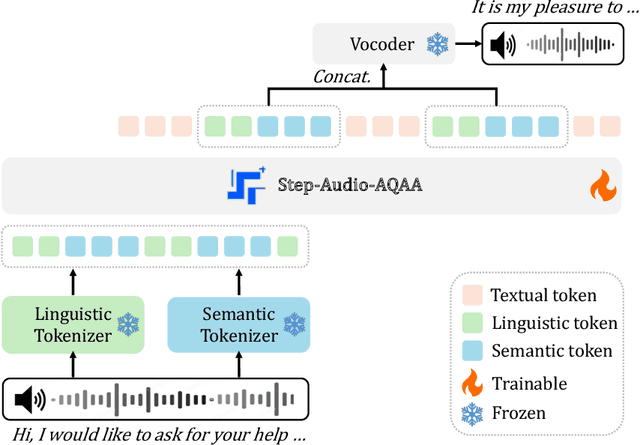
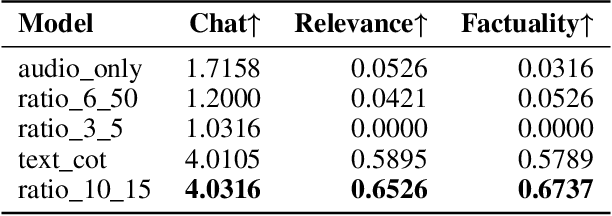
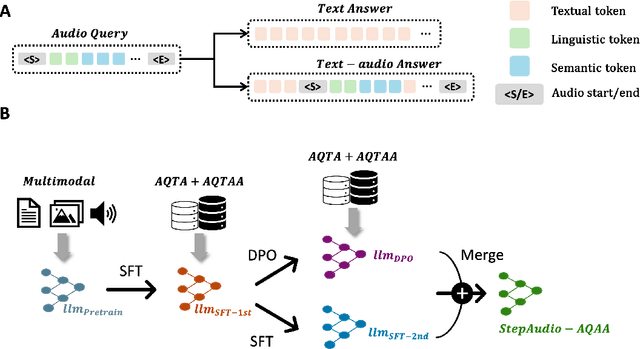

Abstract:Large Audio-Language Models (LALMs) have significantly advanced intelligent human-computer interaction, yet their reliance on text-based outputs limits their ability to generate natural speech responses directly, hindering seamless audio interactions. To address this, we introduce Step-Audio-AQAA, a fully end-to-end LALM designed for Audio Query-Audio Answer (AQAA) tasks. The model integrates a dual-codebook audio tokenizer for linguistic and semantic feature extraction, a 130-billion-parameter backbone LLM and a neural vocoder for high-fidelity speech synthesis. Our post-training approach employs interleaved token-output of text and audio to enhance semantic coherence and combines Direct Preference Optimization (DPO) with model merge to improve performance. Evaluations on the StepEval-Audio-360 benchmark demonstrate that Step-Audio-AQAA excels especially in speech control, outperforming the state-of-art LALMs in key areas. This work contributes a promising solution for end-to-end LALMs and highlights the critical role of token-based vocoder in enhancing overall performance for AQAA tasks.
Trajectory Entropy: Modeling Game State Stability from Multimodality Trajectory Prediction
Jun 06, 2025Abstract:Complex interactions among agents present a significant challenge for autonomous driving in real-world scenarios. Recently, a promising approach has emerged, which formulates the interactions of agents as a level-k game framework. It effectively decouples agent policies by hierarchical game levels. However, this framework ignores both the varying driving complexities among agents and the dynamic changes in agent states across game levels, instead treating them uniformly. Consequently, redundant and error-prone computations are introduced into this framework. To tackle the issue, this paper proposes a metric, termed as Trajectory Entropy, to reveal the game status of agents within the level-k game framework. The key insight stems from recognizing the inherit relationship between agent policy uncertainty and the associated driving complexity. Specifically, Trajectory Entropy extracts statistical signals representing uncertainty from the multimodality trajectory prediction results of agents in the game. Then, the signal-to-noise ratio of this signal is utilized to quantify the game status of agents. Based on the proposed Trajectory Entropy, we refine the current level-k game framework through a simple gating mechanism, significantly improving overall accuracy while reducing computational costs. Our method is evaluated on the Waymo and nuPlan datasets, in terms of trajectory prediction, open-loop and closed-loop planning tasks. The results demonstrate the state-of-the-art performance of our method, with precision improved by up to 19.89% for prediction and up to 16.48% for planning.
DGOcc: Depth-aware Global Query-based Network for Monocular 3D Occupancy Prediction
Apr 10, 2025Abstract:Monocular 3D occupancy prediction, aiming to predict the occupancy and semantics within interesting regions of 3D scenes from only 2D images, has garnered increasing attention recently for its vital role in 3D scene understanding. Predicting the 3D occupancy of large-scale outdoor scenes from 2D images is ill-posed and resource-intensive. In this paper, we present \textbf{DGOcc}, a \textbf{D}epth-aware \textbf{G}lobal query-based network for monocular 3D \textbf{Occ}upancy prediction. We first explore prior depth maps to extract depth context features that provide explicit geometric information for the occupancy network. Then, in order to fully exploit the depth context features, we propose a Global Query-based (GQ) Module. The cooperation of attention mechanisms and scale-aware operations facilitates the feature interaction between images and 3D voxels. Moreover, a Hierarchical Supervision Strategy (HSS) is designed to avoid upsampling the high-dimension 3D voxel features to full resolution, which mitigates GPU memory utilization and time cost. Extensive experiments on SemanticKITTI and SSCBench-KITTI-360 datasets demonstrate that the proposed method achieves the best performance on monocular semantic occupancy prediction while reducing GPU and time overhead.
Bayesian Optimization for Controlled Image Editing via LLMs
Feb 26, 2025



Abstract:In the rapidly evolving field of image generation, achieving precise control over generated content and maintaining semantic consistency remain significant limitations, particularly concerning grounding techniques and the necessity for model fine-tuning. To address these challenges, we propose BayesGenie, an off-the-shelf approach that integrates Large Language Models (LLMs) with Bayesian Optimization to facilitate precise and user-friendly image editing. Our method enables users to modify images through natural language descriptions without manual area marking, while preserving the original image's semantic integrity. Unlike existing techniques that require extensive pre-training or fine-tuning, our approach demonstrates remarkable adaptability across various LLMs through its model-agnostic design. BayesGenie employs an adapted Bayesian optimization strategy to automatically refine the inference process parameters, achieving high-precision image editing with minimal user intervention. Through extensive experiments across diverse scenarios, we demonstrate that our framework significantly outperforms existing methods in both editing accuracy and semantic preservation, as validated using different LLMs including Claude3 and GPT-4.
Step-Audio: Unified Understanding and Generation in Intelligent Speech Interaction
Feb 18, 2025Abstract:Real-time speech interaction, serving as a fundamental interface for human-machine collaboration, holds immense potential. However, current open-source models face limitations such as high costs in voice data collection, weakness in dynamic control, and limited intelligence. To address these challenges, this paper introduces Step-Audio, the first production-ready open-source solution. Key contributions include: 1) a 130B-parameter unified speech-text multi-modal model that achieves unified understanding and generation, with the Step-Audio-Chat version open-sourced; 2) a generative speech data engine that establishes an affordable voice cloning framework and produces the open-sourced lightweight Step-Audio-TTS-3B model through distillation; 3) an instruction-driven fine control system enabling dynamic adjustments across dialects, emotions, singing, and RAP; 4) an enhanced cognitive architecture augmented with tool calling and role-playing abilities to manage complex tasks effectively. Based on our new StepEval-Audio-360 evaluation benchmark, Step-Audio achieves state-of-the-art performance in human evaluations, especially in terms of instruction following. On open-source benchmarks like LLaMA Question, shows 9.3% average performance improvement, demonstrating our commitment to advancing the development of open-source multi-modal language technologies. Our code and models are available at https://github.com/stepfun-ai/Step-Audio.
Systematic Outliers in Large Language Models
Feb 10, 2025

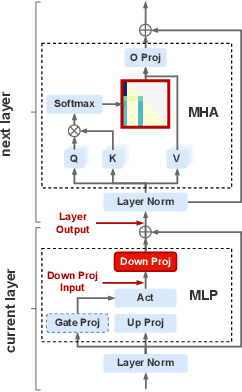

Abstract:Outliers have been widely observed in Large Language Models (LLMs), significantly impacting model performance and posing challenges for model compression. Understanding the functionality and formation mechanisms of these outliers is critically important. Existing works, however, largely focus on reducing the impact of outliers from an algorithmic perspective, lacking an in-depth investigation into their causes and roles. In this work, we provide a detailed analysis of the formation process, underlying causes, and functions of outliers in LLMs. We define and categorize three types of outliers-activation outliers, weight outliers, and attention outliers-and analyze their distributions across different dimensions, uncovering inherent connections between their occurrences and their ultimate influence on the attention mechanism. Based on these observations, we hypothesize and explore the mechanisms by which these outliers arise and function, demonstrating through theoretical derivations and experiments that they emerge due to the self-attention mechanism's softmax operation. These outliers act as implicit context-aware scaling factors within the attention mechanism. As these outliers stem from systematic influences, we term them systematic outliers. Our study not only enhances the understanding of Transformer-based LLMs but also shows that structurally eliminating outliers can accelerate convergence and improve model compression. The code is avilable at https://github.com/an-yongqi/systematic-outliers.
Exploiting Multimodal Spatial-temporal Patterns for Video Object Tracking
Dec 20, 2024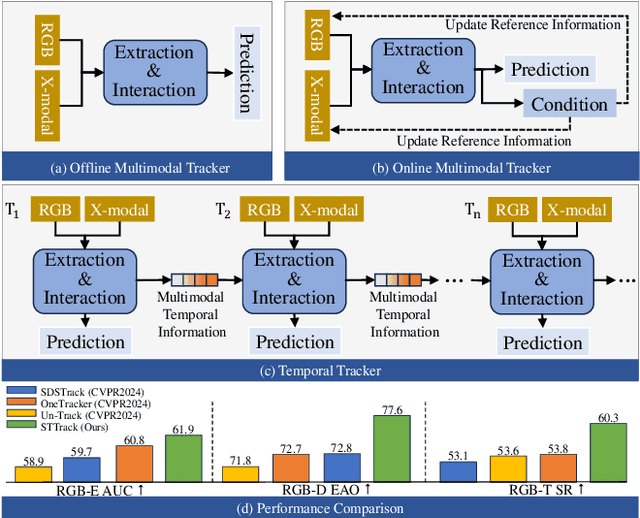
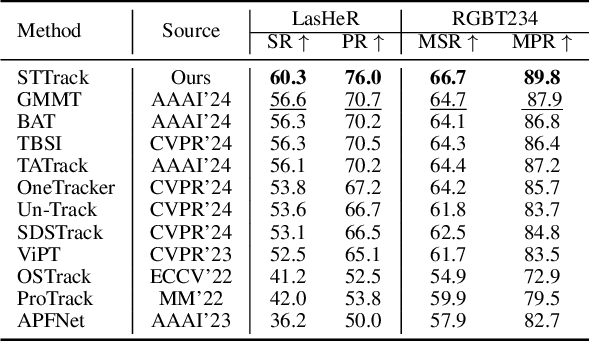
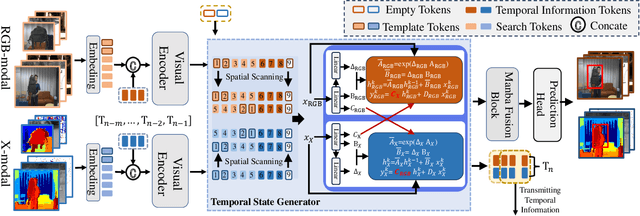
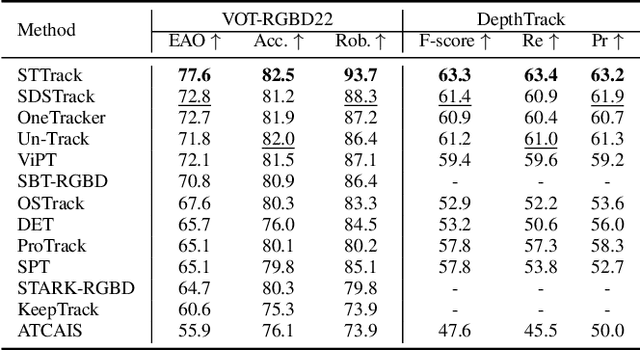
Abstract:Multimodal tracking has garnered widespread attention as a result of its ability to effectively address the inherent limitations of traditional RGB tracking. However, existing multimodal trackers mainly focus on the fusion and enhancement of spatial features or merely leverage the sparse temporal relationships between video frames. These approaches do not fully exploit the temporal correlations in multimodal videos, making it difficult to capture the dynamic changes and motion information of targets in complex scenarios. To alleviate this problem, we propose a unified multimodal spatial-temporal tracking approach named STTrack. In contrast to previous paradigms that solely relied on updating reference information, we introduced a temporal state generator (TSG) that continuously generates a sequence of tokens containing multimodal temporal information. These temporal information tokens are used to guide the localization of the target in the next time state, establish long-range contextual relationships between video frames, and capture the temporal trajectory of the target. Furthermore, at the spatial level, we introduced the mamba fusion and background suppression interactive (BSI) modules. These modules establish a dual-stage mechanism for coordinating information interaction and fusion between modalities. Extensive comparisons on five benchmark datasets illustrate that STTrack achieves state-of-the-art performance across various multimodal tracking scenarios. Code is available at: https://github.com/NJU-PCALab/STTrack.
Monocular Lane Detection Based on Deep Learning: A Survey
Nov 26, 2024



Abstract:Lane detection plays an important role in autonomous driving perception systems. As deep learning algorithms gain popularity, monocular lane detection methods based on deep learning have demonstrated superior performance and emerged as a key research direction in autonomous driving perception. The core design of these algorithmic frameworks can be summarized as follows: (1) Task paradigm, focusing on lane instance-level discrimination; (2) Lane modeling, representing lanes as a set of learnable parameters in the neural network; (3) Global context supplementation, enhancing the detection of obscure lanes; (4) Perspective effect elimination, providing 3D lanes usable for downstream applications. From these perspectives, this paper presents a comprehensive overview of existing methods, encompassing both the increasingly mature 2D lane detection approaches and the developing 3D lane detection works. For a relatively fair comparison, in addition to comparing the performance of mainstream methods on different benchmarks, their inference speed is also investigated under a unified setting. Moreover, we present some extended works on lane detection, including multi-task perception, video lane detection, online high-definition map construction, and lane topology reasoning, to offer readers a comprehensive roadmap for the evolution of lane detection. Finally, we point out some potential future research directions in this field. We exhaustively collect the papers and codes of existing works at https://github.com/Core9724/Awesome-Lane-Detection and will keep tracing the research.
 Add to Chrome
Add to Chrome Add to Firefox
Add to Firefox Add to Edge
Add to Edge